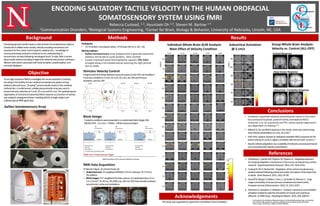Custead_CB3_Poster v3
•Download as PPTX, PDF•
0 likes•49 views
1) Researchers used fMRI to study how the human orofacial somatosensory system encodes tactile velocity during saltatory pneumatic stimulation of the lower face. 2) They found that unilateral stimulation produced localized BOLD responses in SI, SII, precentral and PPC that varied spatially depending on stimulus velocity. 3) Bilateral activation of SI, SII and insular cortex occurred for slower velocities, and some subjects showed ipsilateral cerebellar activation at the slowest velocity.
Report
Share
Report
Share

Recommended
Recommended
More Related Content
What's hot
What's hot (17)
Tognoli & Kelso, Society for Neuroscience 2009, diversity of 10Hz rhythms in ...

Tognoli & Kelso, Society for Neuroscience 2009, diversity of 10Hz rhythms in ...
International Journal of Engineering Research and Development (IJERD)

International Journal of Engineering Research and Development (IJERD)
Brain Computer Interface for User Recognition And Smart Home Control

Brain Computer Interface for User Recognition And Smart Home Control
Modulation of theta phase sync during a recognition memory task

Modulation of theta phase sync during a recognition memory task
Explain how biological factors may affect one Cognitive process.

Explain how biological factors may affect one Cognitive process.
Sex differences in brain activation elicited by humor

Sex differences in brain activation elicited by humor
Similar to Custead_CB3_Poster v3
'Psiquiatría: situación actual y perspectivas de futuro'. Este es el título del simposio internacional que organizamos el 20 de junio de 2016 en la Fundación Ramón Areces con las fundaciones Juan José López-Ibor y Lilly en homenaje al doctor Juan José López-Ibor, fallecido en enero de 2015. Durante esta jornada, expertos internacionales abordaron la profunda crisis que atraviesa la psiquiatría como disciplina científica y especialidad médica. Además, se presentó el libro con el mismo título del simposio, también en recuerdo del doctor López-Ibor. Jorge Alberto Costa e Silva-Psiquiatría: situación actual y perspectivas de f...

Jorge Alberto Costa e Silva-Psiquiatría: situación actual y perspectivas de f...Fundación Ramón Areces
The sophisticated signal processing techniques developed during last years for structural and functional imaging methods allow us to detect abnormalities of brain connectivity in brain disorders with unprecedented detail. Interestingly, recent works shed light on both functional and structural underpinnings of musical anhedonia (i.e., the individual's incapacity to enjoy listening to music). On the other hand, computational models based on brain simulation tools are being used more and more for mapping the functional consequences of structural abnormalities. The latter could help to better understand the mechanism that is impaired in people unable to derive pleasure from music, and formulate hypotheses on how music acquired reward value. The presentation gives an overview of today's studies and proposes a possible simulation pipeline to reproduce such scenario.Structural and functional neural correlates of emotional responses to music

Structural and functional neural correlates of emotional responses to musicFacultad de Informática UCM
Similar to Custead_CB3_Poster v3 (20)
Functional Ultrasound (fUS) Imaging in the Brain of Awake Behaving Mice

Functional Ultrasound (fUS) Imaging in the Brain of Awake Behaving Mice
Jorge Alberto Costa e Silva-Psiquiatría: situación actual y perspectivas de f...

Jorge Alberto Costa e Silva-Psiquiatría: situación actual y perspectivas de f...
Analysis of Functional Magnetic Resonance Imaging (fMRI) data from human brai...

Analysis of Functional Magnetic Resonance Imaging (fMRI) data from human brai...
Micro-Neuro-Sensor Recording of STN Neurons of the Human Brain

Micro-Neuro-Sensor Recording of STN Neurons of the Human Brain
Structural and functional neural correlates of emotional responses to music

Structural and functional neural correlates of emotional responses to music
The Impact of Neurodegeneration on Network Connectivity: A Study of Change De...

The Impact of Neurodegeneration on Network Connectivity: A Study of Change De...
Custead_CB3_Poster v3
- 1. ENCODING SALTATORY TACTILE VELOCITY IN THE HUMAN OROFACIAL SOMATOSENSORY SYSTEM USING fMRI Rebecca Custead, 1,3, Hyuntaek Oh 2,3, Steven M. Barlow 1-3 1Communication Disorders, 2Biological Systems Engineering, 3Center for Brain, Biology & Behavior, University of Nebraska, Lincoln, NE, USA Processingdynamic tactileinputsisakeyfunctionofsomatosensorysystems. Closelytiedtoskilled motoractivity, velocityencoding mechanismsare importantforfinemotorcontrol(speech,swallow,etc.). Knowledgeof sensoryprocessing networkscontributetoourunderstanding of sensorimotorrecoveryfollowing neurologicalinsult.Todate,littleisknown abouttactilevelocityencoding intrigeminalnetworksthatprocesscutaneous afferentinformation associated withfacialsensation, proprioception, and oromotorfeedback. Background Objective Methods Results Acknowledgements Conclusions References Tousehighresolution fMRItoinvestigatetheneuralsubstratesofvelocity encodinginthehealthyhuman orofacialsomatosensorysystemduring saltatory(discontinuous, “jumping”) pneumotactileinputstotheunilateral orofacialskin.Amultichannel, scalablepneumotactilearraywasusedto presentstimulusvelocitiesat5cm/s,25cm/sand65cm/s.Thespatiotemporal organizationofcorticalandsubcorticalBOLDresponseasafunctionofvelocity wasanalyzedusing generallinearmodeling (GLM)ofsingle-subjectand collapsedgroupfMRIsignaldata. Galileo Somatosensory Array Participants • 14 R-handed, neurotypicaladults, 19-30years(M=21.2,SD=1.8) StimulusDelivery • Galileo Somatosensory array, programmed to generate sequential saltatory stimuli (60 ms pulse duration, 10ms rise/fall) • Custom-machined acetyl thermopolymer capsules (TAC-Cells) arranged along a line (medial-lateral) spanning the right perioral skin-to-cheek fMRI Data Acquisition Stimulus Velocity Control ThisstudywassupportedbyagrantfromtheBarkleyTrustFoundation. • Unilateral, sequential saltatory pneumotactile inputs to the lower face produced localized, predominantly contralateral BOLD responses in SI, SII, precentral and PPC, whose spatial organization was dependent on velocity.1, 2 • BilateralSI,SII,andBOLDresponseintheinsularcortexwasnotedduring slowvelocitypresentations(5cm/s,25cm/s).³ • HalfofthesubjectsshowedanipsilateralcerebellarBOLDresponseforthe lowestvelocity(5cm/s)inregionsconsistentwiththedentate nucleus.4 • Resultsindicateadaptationviaascalabilityofnetworksprocessingtemporal cuesassociatedwithvelocitypresentations 1. VenkatesanL,BarlowSM,PopescuM,PopescuA. Integrating approach forstudying adaptationmechanismsinthehumansomatosensorycortical network. ExperimentalBrainResearch 2014,232:3545-3554. 2. CusteadR,OhH,BarlowSM. Adaptation ofthecorticalsomatosensory evokedpotentialfollowing pulsedpneumatic stimulationofthelowerface inadults. BrainResearch 2015,1622:81-90. 3. AronoffR,MatyasF,MateoC,Ciron,C,SchneiderB,PetersonC. Long- rangeconnectivityofmouseprimarysomatosensorybarrelcortex. EuropeanJournalofNeuroscience 2010,31:2221-2233. 4. WardmanD,GandeviaS,ColebatchJ. Cerebral,subcortical, andcerebellar activationevokedbyselectivestimulation ofmuscleandcutaneous afferents:anfMRIstudy. PhysiologicalReports 2014,2(4):e00270. Individual Whole-Brain GLM Analysis: Main Effect of Velocity Condition Block Design ProgrammedtimedelaysbetweenpressurepulsesateachTAC-cellresultedin 5stimulusconditions: 5cm/s,25cm/s,65cm/s,ALL-ONsynchronous activation, andALL-OFF 5velocityconditionswerepresentedinarandomizedblockdesign(20s ON/20sOFF), 13.3min=1BOLD, 3BOLDsessions/subject 3TSiemensSkyra,32-channelheadcoil • Anatomicalscan:(T1-weightedMPRAGE,0.9mmisotropic, TE=3.37ms, TR=2400ms • BOLDimages:(T2*-weightedEPI)brainvolume,41interleavedslices(2.5x 2.5x2.5mm³, TE=30ms,TR=2500ms),220mmFOVthatincludedorofacial sensorimotorcortexandcerebellum Subcortical Activation: @ 5 cm/s Group Whole-Brain Analysis: Velocity vs. Control (ALL-OFF) Cortical Response: Deep Insular Response: Subcortical - Cerebellar Response: 2015 Subject Subject It is the policy of the University of Nebraska-Lincoln not to discriminate based upon age, race, ethnicity, color, national origin, gender, sex, pregnancy, disability, sexual orientation, genetic information, veteran's status, marital status, religion or political affiliation.
